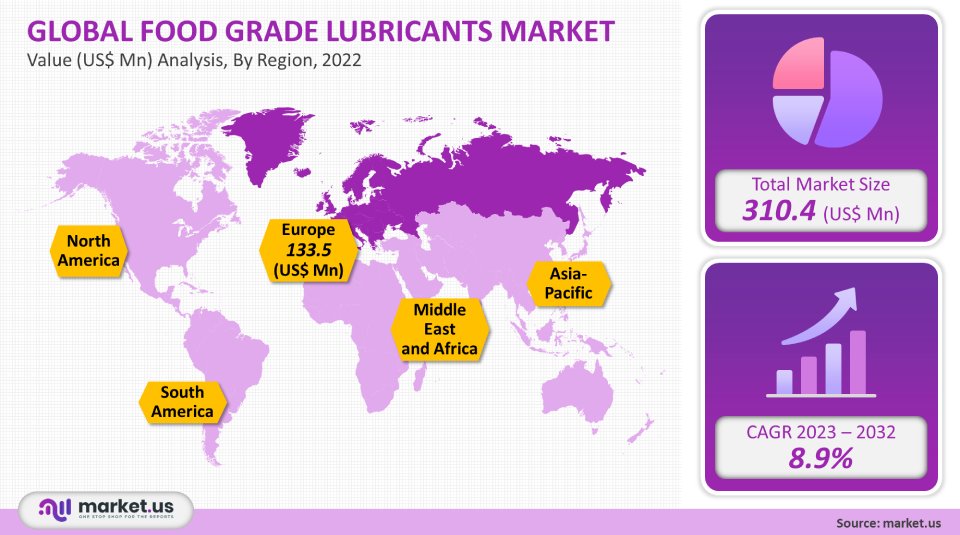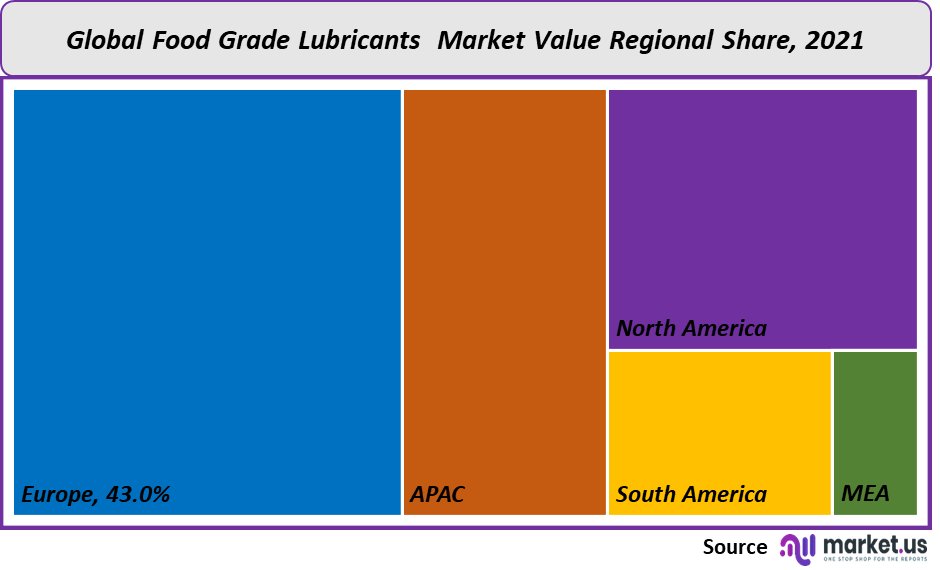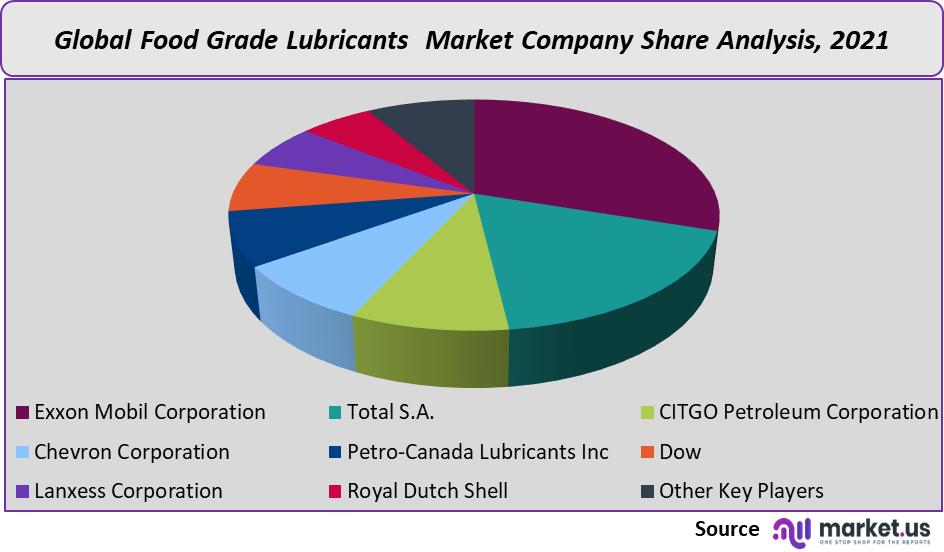Global Food Grade Lubricants Market By Product Type (Mineral, Synthetic and Bio-based), By Application (Food, Beverage, Pharmaceuticals, Cosmetics, and Other Applications), By Region and Companies - Industry Segment Outlook, Market Assessment, Competition Scenario, Trends and Forecast 2022-2032
- Published date: Nov 2021
- Report ID: 15930
- Number of Pages: 201
- Format:
- keyboard_arrow_up
Food Grade Oil Lubricants Market Overview:
The 2021 global food-grade oil lubricants market was worth USD 310.4 million. It is projected to increase at a compound annual rate CAGR of 8.9% between 2022 and 2032. Food-grade oils will see an increase in the consumption of beverages, processed foods, and lubricants.
Global Food Grade Lubricants Market Scope:
Product type analysis
In 2021, the mineral product category made up more than 62.0% of the market’s food-grade lubricants revenue. Mineral food-grade lubricants are ideal for machinery like hydraulic systems operating at temperatures of 120degF-150degF. Low cost is what will continue to drive the requirement for mineral-based products. These include lubricants that can be used for food and beverages and cosmetics.
Synthetic-based oils were the 2nd largest product group in revenue and volume in 2021.Synthetic oils offer excellent performance at very low and extremely high temperatures. These products are safe for use in all climates. This protects metal surfaces from rust and wears while reducing downtime. These factors, along with requirements for synthetic product types, are forecast to drive significant needs over the forecast.
Food-grade oils are currently in transition. They have to now comply with new regulations as well as bio-based products. These are likely to increase high recognition due to the increasing need for natural or environment-friendly lubricating products in the beverage, food, and cosmetics industries. According to revenue growth projections, the bio-based Lubricant segment will grow at 9.9% annually from 2021-to 2028.

Application analysis
The rising consumer awareness and desire for high-quality products such as meat will drive the global meat and poultry, and seafood industry. The high requirement for the product is due to increased consumption in bakery, dairy, meat, poultry, confectionery, seafood, dressings & sauces among other applications. The food application sector held the largest market share in 2021, which accounted for 61.2% of the total revenue.
Due to the substantial increase in order among the global millennial population, the demand for alcoholic beverages is rising rapidly. The beverage market includes the consumption of Soft Drinks (CSD), fruit drinks, functional drinks, and other applications. Due to growing concerns about many health issues, including obesity and nutritional deficiencies, the demand for fruit beverages will rise. Healthy lifestyles are increasing the need for fruit beverages.
Pharmaceutical applications can use food-grade lubricants that regulatory agencies like ISO and FDA have approved. This is projected to increase the need for the product soon. Increased R&D investment for new product innovations and rising health concerns are likely to drive the development of the pharmaceutical market.
The rising requirement is increasing awareness of skincare products, increased inclination to maintain even skin tones, and effort to look beautiful and young. The market for food-quality lubricants will see steady growth in the coming years due to the rising need for cosmetic products such as eye shadows, lipsticks, and other skincare products.
Key Market Segment:
By Product Type
- Mineral
- Synthetic
- Bio-based
By Application
- Food
- Beverage
- Pharmaceuticals
- Cosmetics
- Other Applications
Market Dynamics:
Over the forecast period, there will be a growing requirement for lubricants within the end-use market, including food, beverages, and pharmaceuticals. Over the forecast period, there will be an increase in the consumption of milk, meat, and drinks, which is expected to drive the demand for food-grade oils.
British Petroleum and Total SA are major oil and gas companies.Exxon Mobil Corporation is one of the integrated manufacturers of lubricants. This ensures a steady raw material supply for additives and mineral oil needed to make lubricants. Some lubricant companies have both definitive contracts with suppliers and raw materials manufacturers. This allows these companies to reduce the risk of price fluctuations and minimize time lost in procuring this material.
Bio-based oil lubricants are becoming more widely known as an alternative to petroleum-based products in many areas, including the automotive and food industry. These are made from animal fats and vegetable oils. Bio-lubricants undergo chemical modifications such as esterifications, transesterifications, and oxidation to make advanced natural oils. Natural oils are less expensive than mineral oils, more readily available, and biodegradable. Canola oil and soybean with high oleic content are now the preferred base oils for biodegradable oils.
The increase is rising for bio-based oils and lubricants at a rapid rate. Thanks to their stringent environmental policies and increasing awareness, Europe and North America have become the top two consumers of these products. The Asia Pacific leads the market for synthetic oils while lagging in the bio-lubricants category. The Asia Pacific markets have adopted the American, European, and Japanese regulatory systems. Many countries like South Korea and Japan now emphasize eco-labeled Lubricating Products.
Regional Analysis:
Europe was the dominant market for food-grade oils in 2021, with a 43.0% revenue share. It is predicted that the region will experience a CAGR between 2023-2032 of 7.0%. In most European countries, strict EPA and REACH regulations have encouraged manufacturers to concentrate on developing biobased lubricants. It is anticipated that bio-based alternatives will continue to pose a severe threat to the growth and development of mineral-based products.
North America’s appetite for food-grade lubricants has been primarily driven by Mexico’s rapid industrialization. Mexico has become an important manufacturing hub over the past decade. Mexico is being seen as a potential growth market after the success of BRIC. It continues to see steady growth centered around its food and beverage sector.
Food-grade lubricants demand is predicted to rise due to the growth of bio-based products in America. The U.S. has long used food-grade lubricants of high quality for decades. This is due to their longer oil drain intervals and lower consumption.

Key Regions and Countries covered in the report:
- North America
- US
- Canada
- Mexico
- Europe
- Germany
- UK
- France
- Italy
- Russia
- Spain
- Rest of Europe
- APAC
- China
- Japan
- South Korea
- India
- Rest of Asia-Pacific
- South America
- Brazil
- Argentina
- Rest of South America
- MEA
- GCC
- South Africa
- Israel
- Rest of MEA
Market Share & Key Players Analysis:
To stay ahead in the competitive market, market leaders are constantly looking to expand their capacity and sign partnership agreements with distributors. Manufacturers try to reach potential buyers of their products through these strategies. Royal Dutch Shell and Chevron Corporation dominate the market. Their products are tailored to each market and they have a global brand presence.
Forecasts predict that the demand for oil lubricants will continue to grow. Manufacturers are constantly improving their product offerings and creating new products to keep up with changing market needs. Exxon Mobil by SHC series is some of the leading lubricants in the renewable industry. They are likely to be the focus of most manufacturers’ innovation. The following are the major players in the food-grade lubricants market:

Маrkеt Кеу Рlауеrѕ:
- Exxon Mobil Corporation
- Total S.A.
- CITGO Petroleum Corporation
- Chevron Corporation
- Petro-Canada Lubricants Inc
- Dow
- Lanxess Corporation
- Royal Dutch Shell
- Other Key Players
For the Food Grade Lubricants Market research study, the following years have been considered to estimate the market size:
Attribute Report Details Historical Years
2016-2020
Base Year
2021
Estimated Year
2022
Short Term Projection Year
2028
Projected Year
2023
Long Term Projection Year
2032
Report Coverage
Competitive Landscape, Revenue analysis, Company Share Analysis, Manufacturers Analysis, Volume by Manufacturers, Key Segments, Key company analysis, Market Trends, Distribution Channel, Market Dynamics, COVID-19 Impact Analysis, strategy for existing players to grab maximum market share, and more.
Regional Scope
North America, Europe, Asia-Pacific, South America, Middle East & Africa
Country Scope
United States, Canada and Mexico, Germany, France, UK, Russia and Italy, China, Japan, Korea, India and Southeast Asia, Brazil, Argentina, Colombia etc.Saudi Arabia, UAE, Egypt, Nigeria and South Africa
Frequently Asked Questions (FAQ)
Q: What is the Food Grade Lubricants market size in 2021?The Food Grade Lubricants market size is $ 310.4 million in 2021.
Q: What is the CAGR for the Food Grade Lubricants market?The Food Grade Lubricants market is expected to grow at a CAGR of 8.9% during 2023-2032.
Q: What are the segments covered in the Food Grade Lubricants market report?Market.US has segmented the Food Grade Lubricants market by geographic (North America, Europe, APAC, South America, and Middle East and Africa). By Product Type, market has been segmented into Mineral, Synthetic, Bio-based. By Application, the market has been further divided into Food Beverage, Pharmaceuticals, Cosmetics, and Others
Q: Who are the key players in the Food Grade Lubricants market?Exxon Mobil Corporation, Total S.A., CITGO Petroleum Corporation, Chevron Corporation, Petro-Canada Lubricants Inc, Dow, Lanxess Corporation, Royal Dutch Shell, Other Key Players are the key vendors in the Food Grade Lubricants market
Q: Which region is more attractive for vendors in the Food Grade Lubricants market?Europe is accounted for the highest revenue Share of 43.0% among the other regions. Therefore, the Food Grade Lubricants market in Europe is expected to garner significant business opportunities for the vendors during the forecast period.
Q: What are the key markets for Food Grade Lubricants?Key markets for Food Grade Lubricants Are U.S, Canada, Germany, U.K., France, Japan, Italy, Brazil.
Q: Which segment has the largest share in the Food Grade Lubricants market?In the Food Grade Lubricants market, vendors should focus on grabbing business opportunities from the mineral segment as it accounted for the largest market share in the base year.
![Food Grade Lubricants Market Food Grade Lubricants Market]() Food Grade Lubricants MarketPublished date: Nov 2021add_shopping_cartBuy Now get_appDownload Sample
Food Grade Lubricants MarketPublished date: Nov 2021add_shopping_cartBuy Now get_appDownload Sample - Exxon Mobil Corporation Company Profile
- Total S.A.
- CITGO Petroleum Corporation
- Chevron Corporation
- Petro-Canada Lubricants Inc
- Dow
- Lanxess Corporation
- Royal Dutch Shell
- Other Key Players
- settingsSettings
Our Clients
|
Single User
$5,999
$2,999
USD / per unit
save 50% |
Multi User
$7,999
$3,499
USD / per unit
save 55% |
Corporate User
$12,999
$4,499
USD / per unit
save 65% | |
|---|---|---|---|
| e-Access | |||
| Data Set (Excel) | |||
| Company Profile Library Access | |||
| Interactive Dashboard | |||
| Free Custumization | No | up to 10 hrs work | up to 30 hrs work |
| Accessibility | 1 User | 2-5 User | Unlimited |
| Analyst Support | up to 20 hrs | up to 40 hrs | up to 50 hrs |
| Benefit | Up to 20% off on next purchase | Up to 25% off on next purchase | Up to 30% off on next purchase |
| Buy Now ($ 2,999) | Buy Now ($ 3,499) | Buy Now ($ 4,499) |









